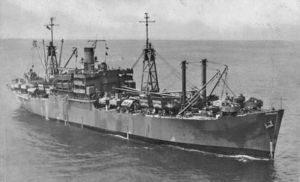USS New Hanover (AKA-73)
 Tolland class AKA, similar to USS New Hanover Tolland class AKA, similar to USS New Hanover | |
| History | |
|---|---|
| Laid down: | 31 August 1944 |
| Launched: | 31 October 1944 |
| Commissioned: | 22 December 1944 |
| Decommissioned: | 30 July 1946 |
| Struck: | 15 August 1946 |
| Fate: | Merchant service |
| General Characteristics | |
| Hull Type: | C2-S-AJ3 |
| Displacement: | 8,635 tons light, 13,910 tons loaded |
| Length: | 459 ft 2 in (140 m) |
| Beam: | 63 ft (19.2 m) |
| Draft: | 26 ft 4 in (8.0 m) |
| Propulsion: | GE geared steam turbine drive, single propeller, 6,000 shp (4.5 MW) |
| Speed: | 16.5 knots (30.6 km/h) |
| Complement: | 395 (62 officers, 333 men), plus embarked troops |
| Armament: | 1 × 5"/38 caliber DP gun, 4 × twin 40 mm AA guns, 16 × 20 mm AA guns |
| Boats: | 14 LCVP, 8 LCM |
| NOTES: Some sources report different displacements for ships of this type. Speed and complement may have changed as the ship or her mission were modified. Often one or two LCVPs were replaced by LCPLs. 20mm AA guns were sometimes removed. | |
USS New Hanover (AKA-73) was a Tolland class attack cargo ship named after New Hanover County, North Carolina. Like all AKAs, New Hanover was designed to carry military cargo and landing craft, and to use the latter to land weapons, supplies, and Marines on enemy shores during amphibious operations. She served as a commissioned ship for 19 months.
History
New Hanover was laid down 31 August 1944 by North Carolina Shipbuilding Co., Wilmington, North Carolina; launched 31 October 1944; sponsored by Mrs. O. M. Creekmore; and commissioned 22 December 1944 at Charleston, South Carolina, LCDR J. R. Haines, USNR, in command.
After training in Chesapeake Bay, New Hanover cleared Norfolk 24 January 1945 with cargo for the Pacific, sailing through the Panama Canal on 1 February and reaching Pearl Harbor on 19 February. Joining Amphibious Forces, Pacific Fleet, she began a round of cargo operations which took her to the Solomons, New Hebrides, and Ulithi, all in preparation for the assault on Okinawa, off which she arrived 10 April. During the next week of cargo operations, her crew went to General Quarters 30 times as Japanese air attacks harassed the invasion. She returned to Ulithi 23 April and began a series of passages with mail, cargo, and passengers to Guam, the Russells, Eniwetok, and Saipan, serving the bases essential to Pacific victory. She carried passengers to San Francisco in July, then continued cargo and passenger operations which took her to Pearl Harbor, Tinian, Saipan, the Philippines, and ultimately Japan, from which she returned to Pearl Harbor 27 November with passengers and a cargo composed largely of captured Japanese equipment. She sailed for the Canal Zone 29 November, bound for the East Coast. After service on the Atlantic coast she decommissioned at Norfolk 30 July 1946. Transferred to the Maritime Commission 31 July 1946, she was struck from the Naval Register 15 August 1946 and sold in early 1947 and renamed Alaus. Renamed Franklin Berwis in 1955, the ship was again renamed Santa Mercedes in 1957, and Greiea Ward in 1960. The ship serves under the latter name into 1970.
References
- Dictionary of American Naval Fighting Ships (Primary source for this article)